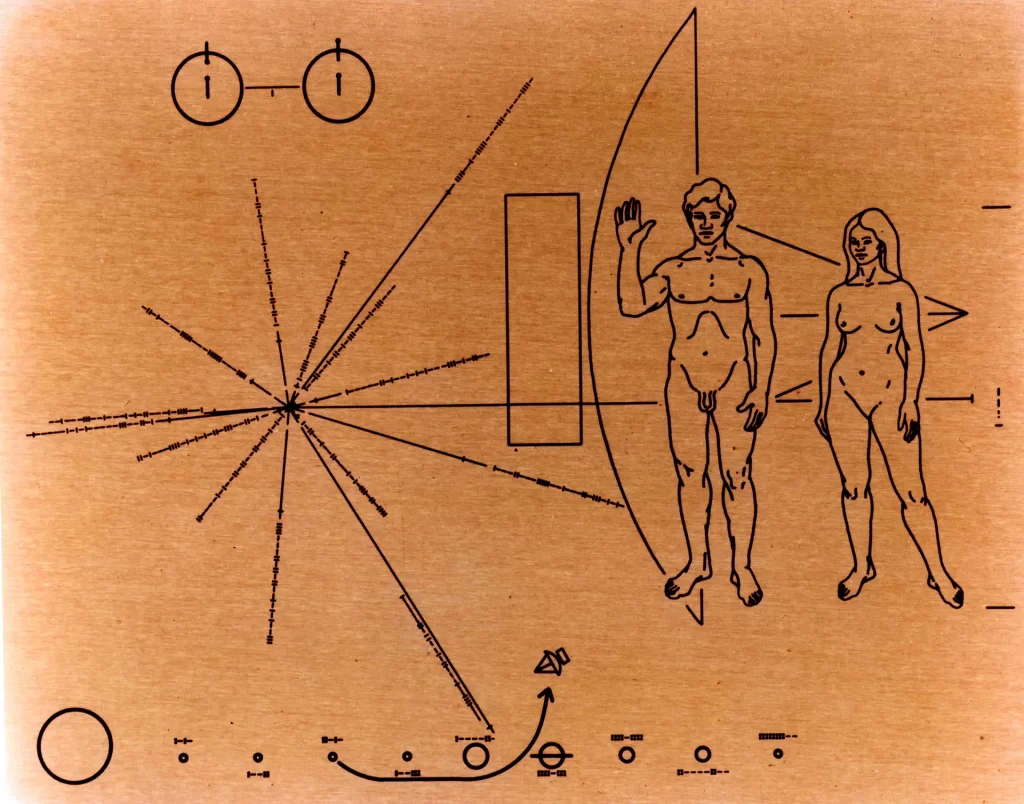In a groundbreaking achievement, scientists have successfully inscribed the complete human genome onto a five-dimensional (5D) crystal, a monumental step in data storage technology that could preserve vast amounts of information for billions of years. This remarkable innovation, developed at the University of Southampton in the UK, is capable of digitally storing up to 360 terabytes of data and holds immense potential for creating enduring records of human, animal, and plant genomes.
A Modern Echo of Pioneer Plaques
The idea of creating a lasting record of humanity isn’t new. Many people may recall the ‘Pioneer plaques’—two gold-colored metal plaques that were attached to the Pioneer 10 and 11 spacecraft, which were launched in the early 1970s. These plaques were designed as a message for any intelligent extraterrestrial life that might encounter the spacecraft. Crafted under the guidance of American astronomer Carl Sagan, the plaques depicted a schematic of our Solar System and illustrated human figures in an effort to communicate our existence and basic understanding of life.
In the spirit of these historical efforts, researchers at the University of Southampton have taken a significant leap forward by creating a modern equivalent using a 5D crystal. This innovative technology not only has the capacity to store vast amounts of information but also ensures that the data remains intact for billions of years without degradation.
The Structure and Function of the 5D Crystal
The creation of the 5D memory crystal is a remarkable feat of engineering, achieved by the University of Southampton’s Optoelectronics Research Center (ORC). Utilizing advanced nanostructured glass, this technology is often referred to as the ‘Superman crystal’—a reference to the 1978 Superman film in which a memory crystal housed an artificial intelligence version of Jor-El, Superman’s biological father.
The inscribing process employs ultra-fast femtosecond lasers to create intricate patterns in self-assembled nanostructured voids within silica. Unlike traditional data storage methods that rely on two-dimensional surfaces such as paper or magnetic tape, this encoding approach utilizes two optical dimensions along with three spatial coordinates to write data throughout the material. This multidimensional encoding allows for a storage capacity of up to 360 terabytes within the 5D crystal.
Moreover, the durability of this technology is astonishing. The 5D crystal can withstand extreme conditions, remaining stable even in freezing temperatures and at heat levels soaring up to 1,000 °C (1,832 °F). Such resilience makes it a suitable medium for preserving critical information over geological time scales, a feature that could prove invaluable for future generations.
Inscribing the Human Genome
To validate the potential of the 5D crystal as a repository for significant genetic information, researchers inscribed the entire human genome into its structure. The human genome comprises approximately three billion base pairs—adenine (A), thymine (T), guanine (G), and cytosine (C)—and the scientists took great care to ensure accuracy. Each letter of the genome was sequenced 150 times, ensuring that it was recorded in the correct position within the crystal.
In addition to the genomic data, the researchers included a key on the crystal that will help any future intelligence—be it human, machine, or extraterrestrial—understand and utilize the information contained within. This key features essential elements such as hydrogen, oxygen, carbon, and nitrogen, as well as the four bases of the DNA molecule, along with their molecular structures. It illustrates how these elements are arranged in the DNA double helix and provides insight into the organization of genes on chromosomes.
Professor Peter Kazansky, who led the research team at the University of Southampton, expressed excitement over the implications of this technology. “We know from the work of others that genetic material from simpler organisms can be synthesized and used in existing cells to create viable living specimens in a lab,” he stated. “The 5D memory crystal opens up possibilities for other researchers to build an everlasting repository of genomic information from which complex organisms like plants and animals might be restored should science in the future allow.”
Preserving Human History and Knowledge

The genome-containing crystal is currently stored securely in a time capsule located within an ancient salt cave in Austria, safeguarded by the Memory of Mankind archive. This ensures that the data will be protected from environmental degradation and human interference for eons.
The implications of storing such vast amounts of information extend beyond mere preservation. As humanity continues to advance technologically, the ability to recreate life from genetic blueprints could become a reality. While we may not yet possess the capability to synthesize humans from their DNA components, the rapid pace of scientific discovery suggests that future developments in genetic engineering could bring such possibilities within reach.
The Future of Data Storage and Genetic Preservation
The creation of the 5D crystal represents a significant milestone in data storage technology and genetic preservation. As we venture further into an era defined by rapid technological advancements, the importance of securing our biological heritage becomes increasingly evident. With the capacity to store entire genomes and vital historical records, this 5D crystal could serve as a foundation for future scientific endeavors aimed at understanding and potentially restoring complex life forms.
Moreover, this technology has the potential to revolutionize how we approach genetic research, conservation efforts, and our understanding of biodiversity. By providing a long-lasting medium for storing genomic information, the 5D crystal enables scientists to maintain a comprehensive record of genetic data that could be invaluable in addressing challenges such as extinction, climate change, and ecological preservation.
Conclusion
The 5D ‘eternity crystal’ is more than just a technological marvel; it symbolizes humanity’s commitment to preserving its knowledge and heritage for future generations. By storing the entire human genome, along with a key for interpretation, this innovative technology serves as a beacon of hope and a reminder of our responsibilities toward our biological legacy.
As research continues and our understanding of genetics evolves, the potential applications of the 5D crystal will likely expand, opening new frontiers in science and technology. Whether it leads to the revival of extinct species, the restoration of endangered plants, or simply serves as an enduring record of human history, the impact of this technology will resonate for generations to come.
The work of researchers at the University of Southampton is a testament to the power of human ingenuity and the ongoing quest to unlock the secrets of life, ensuring that our knowledge and experiences endure, even in the face of time itself.

